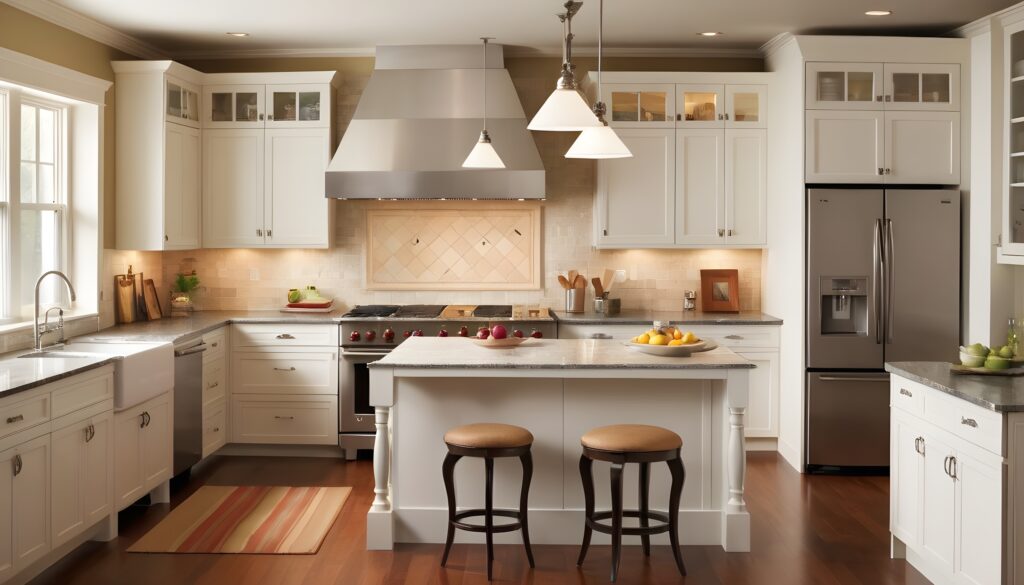Your kitchen is the heart of your home. It’s where you cook delicious meals and make special memories. But if the layout is bad, it can turn into a frustrating mess. It can make cooking less fun and enjoyable. This is why a good kitchen cabinet plan is so important. It helps you create a kitchen that looks great and works well for your needs.
In this guide, we’ll show you step-by-step how to plan the perfect cabinet layout. We’ll help you design an efficient, harmonious kitchen that makes cooking a joy.

Step 1: Assess Your Needs and Preferences for your Kitchen Cabinet
Before you start planning, think about how you live and what you like to cook. Consider how many people are in your home and the types of meals you make often. Do you have any special needs for your kitchen? Do you like to host dinner parties a lot? Do you prefer open shelves or closed cabinets? Answering these questions will help you figure out the best Kitchen Cabinet. Where to put appliances, and the overall look you want for your kitchen.
Step 2: Measure Your Kitchen Space
Getting accurate measurements is key for a successful Kitchen cabinet planner. Carefully measure every part of your kitchen. This includes the walls, windows, doorways, and any appliances or fixtures staying put. Don’t miss things like pipes, vents, or outlets that could get in the way of your new cabinets. Making a detailed floor plan will help you visualize the layout.
With precise measurements from the start, you’ll avoid headaches down the road. This crucial first step sets you up for a seamless cabinet installation. Tailored perfectly to your kitchen’s unique space.
Step 3: Determine the Work Triangle
The work triangle is an important idea in Kitchen Cabinet design. It’s about putting the sink, fridge, and stove in the right spots. Ideally, these three areas should make a triangle shape, with each side no longer than 26 feet total. Arranging them this way minimizes how much you have to walk around. It makes your workflow smoother and more efficient. Following the work triangle keeps your time in the kitchen enjoyable and productive.
Having the main work zones set up correctly is key. The work triangle helps create an orderly kitchen layout tailored to how you use the space. With less unnecessary movement, cooking becomes a much more seamless experience.

Step 4: Plan Your Cabinet Layout
Now for the fun part – designing your dream kitchen cabinet layout! With your measurements and the work triangle rules in mind, you can start planning the functional and stylish heart of your cooking space.
First, decide where to put the different Kitchen Cabinet types. Base cabinets are the tough floor cabinets that provide tons of storage and a solid base for countertops. Wall cabinets offer overhead storage while helping define the space visually.
Consider adding specialty cabinets tailored to your needs. Like a pantry for food storage or an appliance garage to neatly stash small appliances out of sight.
As you plan each cabinet’s placement, think about the ideal heights and depths for easy access. Make sure frequently used items are within comfortable reach to avoid straining. And maximize your storage by incorporating lots of smart solutions – this reduces clutter for an organized, streamlined kitchen.
With creativity and smart planning, you can design a cabinet layout that’s highly functional AND reflects your unique personal style. This is where you get to have fun and make your dream kitchen a reality!
Step 5: Incorporate Lighting and Ventilation in your Kitchen Cabinet
Good lighting in your kitchen matters a ton. It’s not just about seeing better, it’s about creating a cozy atmosphere. Smart lighting does wonders. For tasks, think under-cabinet lights or hanging lamps. They make prepping food safer and easier. Accent lighting adds flair, highlighting cool features and giving your kitchen some extra pizzazz.
Ventilation is key for keeping your kitchen fresh and comfortable while cooking. Savory smells and steam are all part of the fun, but you need good ventilation so those don’t just linger. Invest in a high-quality range hood or exhaust fan installed right over your stove or cooktop.
This will efficiently remove cooking fumes, smoke, and excess moisture. It prevents lingering odors from sticking around and damaging your cabinets or walls. Plus, it improves indoor air quality so you and your guests can breathe easy enjoying your delicious creations!
Step 6: Visualize and Refine
To turn your dream kitchen into reality, seeing it clearly is key. Today’s tech goes beyond flat blueprints. Now, you can peek into a virtual 3D model of your future kitchen. Cool software lets you create super-realistic images. You can check out every corner of your layout before any cabinets go in. Imagine strolling through, opening doors, and seeing how the light hits.
This detail helps you spot any problems early and fine-tune your design to match both your needs and style. Some tools even let you use augmented reality to see how your new kitchen fits into your current space. It’s like getting a sneak peek of the amazing change coming. By visualizing upfront, you dodge costly errors later on.
Step 7: Consider Functionality and Accessories
Don’t stop at just the basic Kitchen Cabinet layout – think about adding functional extras to really boost your kitchen’s usability. Pull-out shelves, lazy Susans, spice racks, or dedicated spots for small appliances can all help maximize efficiency.
Details like hardware and finishes are important too. Choose options that not only complement your kitchen’s overall style, but also make cabinets easy to use day-to-day. The right pulls, hinges, and finishes enhance both form and function.
With some creative thinking about accessories and finishes, you can design a kitchen that beautifully meets all your cooking and storage needs. Simple upgrades can transform your cabinets into hard-working, user-friendly organizational heroes!
Step 8: Consult with Professionals
Planning your kitchen cabinet layout can be a fun DIY project, but don’t go it totally alone. It’s smart to get input from pros who know their stuff. Kitchen designers, contractors, or cabinet makers have expert knowledge to share.
They can provide valuable insights and address any concerns you might have. Their guidance ensures your plan follows all the right building codes and regulations for your area. You don’t want any surprise issues down the road!
Getting professional advice upfront is like having a secret weapon. Experts can troubleshoot potential problems before they happen and offer tips to truly optimize your design. With their help, you’ll end up with a kitchen that looks amazing and functions perfectly.
Step 9: Finalize and Execute
With your well-thought-out plan in hand, it’s time to finalize the details and execute your vision. Whether you’re undertaking a complete kitchen remodel or simply updating your Kitchen Cabinet, your carefully planned layout will serve as a roadmap, ensuring a smooth and efficient installation process.
Conclusion
Throughout this process, remember – your Kitchen Cabinet should reflect your unique style and how you live. Don’t be afraid to get creative and think outside the box! With a well-designed cabinet plan, you can transform your space into a beautiful, ultra-functional kitchen haven. It will be the perfect setting for culinary adventures and making special memories.
Ready to make your dream Kitchen Cabinet a reality? Visit cabinetrus.com today and check out our awesome range of cabinet solutions. Our expert designers will guide you through every step, ensuring a smooth, stress-free experience. With cabinets tailored to your specific needs, you’ll have an efficient kitchen that totally elevates your cooking game.
So embrace your personal style, get those creative juices flowing, and let’s design the kitchen of your dreams! The perfect blend of function and flair awaits. Your culinary happy place is just a few clicks away at cabinetrus.com.



